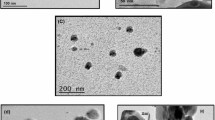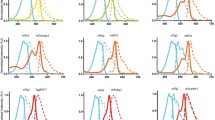Abstract
Two novel FRET-pairs: Tb3+-binding peptide-DsRed2 and Tb3+-binding peptide-TagRFP have been produced based on the terbium-binding peptide and the red fluorescent proteins DsRed2 and TagRFP. Two induction-resonance energy transfer processes in both FRET-pairs have been registered, from tryptophan of the terbium-binding peptide to Tb3+ and from sensitized Tb3+ to the acceptor, the chromophore, DsRed2 or TagRFP. The lifetimes of terbium in the presence and absence of the acceptor have been determined. It has been shown that the lifetime of Tb3+ in the presence of 150 mM NaCl decreases in both FRET-pairs. The efficiency of fluorescent resonance transfer from Tb3+ to the acceptor proteins is 28 and 35% for Tb3+-binding peptide-DsRed2 and Tb3+-binding peptide-TagRFP, respectively.
Similar content being viewed by others
References
P. R. Selvin, Annu. Rev. Biophys. Biomol. Struct. 31, 275 (2002).
I. A. Prokhorenko, V. A. Korshun, and Yu. A. Berlin, Bioorg. Khimiya 25, 838 (1999).
P. Mellet, C. Boudier, Y. Mely, and J. G. Bieth, J. Biol. Chem. 273, 9119 (1998).
U. Kubitscheck, M. Kircheis, R. Schweitzer-Stenner, et al., Biophys. J. 60, 307 (1991).
N. Thelwell, S. Millington, A. Solinas, et al., Nucl. Acids Res. 28, 3752 (2000).
X. Chen, B. Zehnbauer, A. Gnirke, and P. Y. Kwok, Proc. Natl. Acad. Sci. USA 94, 10756 (1997).
E. Soini and H. Kojola, Clin. Chem. 29, 65 (1983).
I. Hemmila and V.-M. Mukkala, Crit. Rev. Clin. Laby. Sci. 38, 441 (2001).
I. Hemmila and V. Laitala, J. Fluoresc. 15, 529 (2005).
A. M. Reynolds, B. R. Sculimbrene, and B. Imperiali, Bioconjugate Chem. 19, 588 (2008).
S. Weissman, J. Chem. Phys. 10, 214 (1942).
L. J. Martin, B. R. Sculimbrene, and M. Nitz, B. Imperiali, QSAR Comb. Sci. 24, 1149 (2005).
I. D. Clark, I. Hill, M. Sikorska-Walker, et al., FEBS Lett. 333, 96 (1993).
M. Xiao and P. R. Selvin, J. Am. Chem. Soc. 123, 7067 (2001).
N. Hildebrandt, L. J. Charbonniere, and H.-G. Lohmannsroben, J. Biomed. Biotech. 12, 1 (2007).
S. W. Yeh, L. J. Ong, A. N. Glazer, and J. H. Clark, Cytometry 8, 91 (1987).
S. M. Riddle, K. L. Vedvik, G. T. Hanson, and K. W. Clark, Anal. Biochem. 356, 108 (2006).
S. Karasawa, T. Araki, T. Nagai, et al., Biochem. J. 381, 307 (2004).
N. C. Shaner, R. E. Campbell, P. Steinbach, et al., Nat. Biotechnol. 22, 1567 (2004).
J. Sambrook, E. F. Fritisch, and T. Maniatis, Molecular Cloning: a Laboratory Manual, 2nd ed. (Cold Spring Harbor Laboratory Press, N.Y., 1989).
C. Yanisch-Perron, J. Vieira, and J. Messing, Gene 33, 103 (1985).
L. R. Arslanbaeva, V. V. Zherdeva, T. V. Ivashina, et al., Prikl. Biokhim. Mikrobiol. 46(2), 166 171 (2010).
M. V. Gorbunkov, P. V. Kostryukov, V. B. Morozov, et al., Kvant. Elektron. 35, 1121 (2005).
M. Cotlet, J. Hofkens, S. Habuchi, et al., Proc. Natl. Acad. Sci. USA 98, 14398 (2001).
E. M. Merzlyak, J. Goedhart, D. Shcherbo, et al., Nat. Meth. 4, 555 (2007).
D. W. Piston and G.-J. Kremers, Trends Biochem. Sci. 32, 407 (2007).
C. Berney and G. Danuser, Biophysical J. 84, 3992 (2003).
D. Parker and J. A. G. Williams, in Metal Ions in Biological Systems. The Lanthanides and Their Interrelations with Biosystems, Ed. by H. Sigel, A. Sigel (Marcel Dekker, N.Y., 2003), Vol. 40, pp. 233–280.
Author information
Authors and Affiliations
Corresponding author
Additional information
Original Russian Text © L.R. Arslanbaeva, V.V. Zherdeva, T.V. Ivashina, L.M. Vinokurov, V.B. Morozov, A.N. Olenin, A.P. Savitskii, 2011, published in Biofizika, 2011, Vol. 56, No. 3, pp. 389–395.
Rights and permissions
About this article
Cite this article
Arslanbaeva, L.R., Zherdeva, V.V., Ivashina, T.V. et al. Induction-resonance energy transfer between the terbium-binding peptide and the red fluorescent proteins DsRed2 and TagRFP. BIOPHYSICS 56, 381–386 (2011). https://doi.org/10.1134/S0006350911030043
Received:
Accepted:
Published:
Issue Date:
DOI: https://doi.org/10.1134/S0006350911030043




